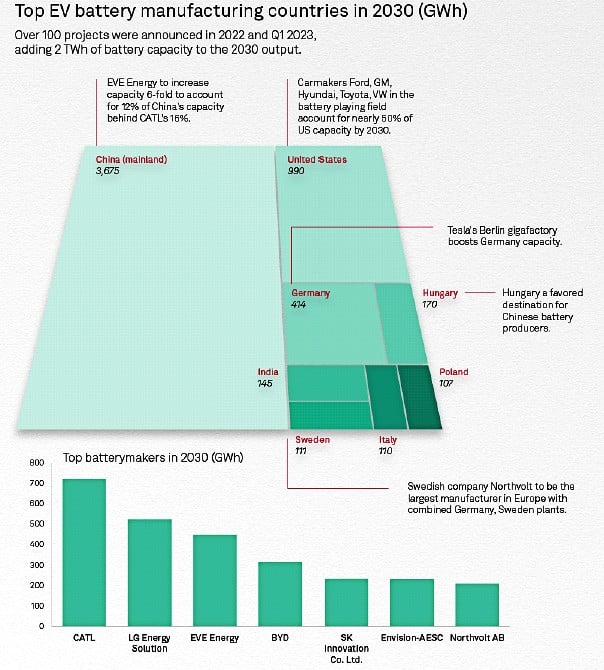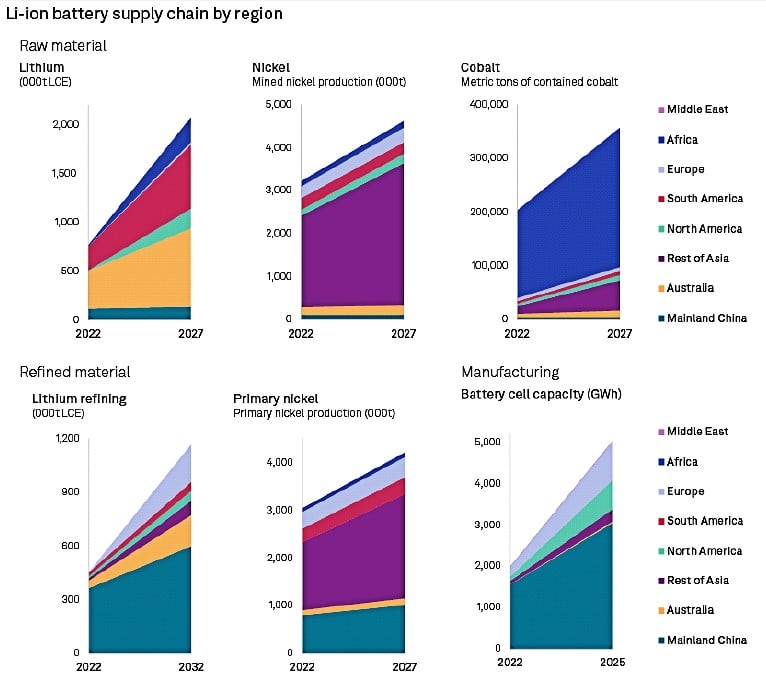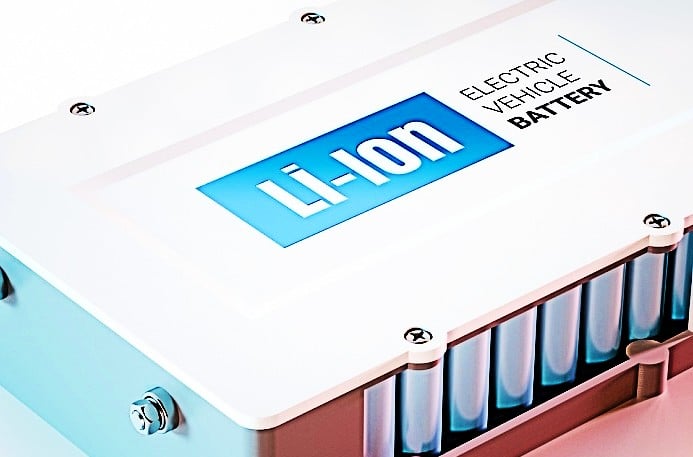S&P Global Commodity Insights published a new report on investments and growth in lithium-ion battery capacity, particularly for the plug-in electric vehicle (EV) sector.
As electrification of the global automotive fleet takes center stage in decarbonizing the transport sector and energy storage calls for renewable sources, lithium gets the spotlight. Considered as the beating heart of net zero, lithium is a critical mineral that’s the key element in making EVs.
With automakers ditching fossil-fueled vehicles and shifting to EVs, that are drawing big market attention, investments in battery capacity are also surging. S&P Global provides good insights on lithium-ion battery capacity growth potential and challenges.
Here are the Report’s Key Takeaways:
-
Lithium-ion Battery Capacity
The report predicts a steady growth in lithium-ion battery capacity, particularly for the plug-in EV sector.
As of the end of the first quarter, global lithium-ion battery production capacity stands at 2.8 TWh. S&P Global predicts that this capacity will grow more than 2-fold by 2030, reaching 6.5 TWh. This planned capacity growth will be enough to cover demand.
-
Lithium-ion Battery Demand
The demand for lithium-powered EV batteries is also projected to grow annually between 2022 and 2030 at over 22% rate. The EV transport segment will snag a market share of 93% in 2030, standing at 3.7 TWh.
-
Battery Production: Market Leaders
China will remain the largest producer of lithium-ion batteries, taking over 50% of the market share. But it will lose some of its market share between 2023 and 2030 due to its already high base.
Europe, the 2nd largest market, and North America will also have significant shares, each boasting 1 TWh of capacity in 2030. Most of the new additions in North America will be from the US, while Canada only has 2 ongoing projects.

As shown above, India’s manufacturing capacity will grow more than 700% to 145 GWh in 2030, up from the current 18 GWh. That will bring India to number five spot next to Hungary.
Battery makers in China also dominate the global market for lithium batteries, namely CATL, BYD, and Eve Energy. Though EV production was down because of no more state subsidies, these EV battery manufacturers remain hopeful on the market’s long-term forecasts.
-
Battery Chemistries
Lithium nickel-manganese-cobalt (NMC) chemistries are the dominant battery chemistry mix so far, due to their superior energy capacity. But NMC batteries account for only over 50% of the global market share this year.
Sourcing for lithium lithium-iron-phosphate or LFP batteries would be easier because of lithium’s abundance across geographies. Also, LFP batteries are cheaper and safer compared to NMC.
In the US, LFP batteries will only make around 20% of the market by 2030, compared with 50.2% for NMC batteries. In Europe, NCM batteries’ share will reach 77.2% in 2030.
-
Battery Supply Chain and Challenges
According to S&P Global, developing the necessary infrastructure, from mines to recycling facilities, to establish the supply chain will be time-consuming. The report provides estimates for raw and refined materials from 2022 to 2027 by region.

Apart from traction batteries, the LFP chemistry mix is also a popular option for stationary energy storage where size and weight of batteries don’t restrict function.
As the sector continues to grow, competition for those critical materials will also increase. And despite a shortage in lithium supply last year, carmakers and traction battery manufacturers involved in offtake agreements with miners still get the volume they need.
The S&P Global report further highlights the potential challenges in the global up- and downstream supply chains. Strict sourcing requirements and long lead times to mine development might be a hurdle for battery capacity development.
Global markets for many of the critical materials will be in deficit before the end of 2030. This could also cause shortages in the supply chain upstream.
-
Battery Recycling
The report also expects a boost to both regional supply chains and the global battery inventory through recycling. Many small companies are working on providing clean technology solutions to battery recycling.
Future Outlook for Lithium-ion Batteries
S&P Global Commodity Insights finally suggests that the industry should focus on exploring new deposits in new geographies and developing new extracting and processing methods to meet the world’s lithium needs.
The financial analyst also reported previously that the U.S. imports of lithium-ion batteries increased 66% in the Q1 2023. Without significantly increasing its domestic lithium supply, the country will be left in the mercy of exporters.
The country has only one source of lithium production, but as America ramps up its EV “Battery Belt”, it needs massive supply. This is where American Lithium Corporation, owning two of the largest lithium deposits in the Americas (in Nevada and Peru) aims to play a major role in delivering the much-needed supply.
Ultimately, countries will scramble to secure enough lithium to realize their domestic EV targets and the global clean energy transition.
Carboncredits.com receives compensation for this publication and has a business relationship with any company whose stock(s) is/are mentioned in this article.
Additional disclosure: This communication serves the sole purpose of adding value to the research process and is for information only. Please do your own due diligence. Every investment in securities mentioned in publications of carboncredits.com involves risks that could lead to a total loss of the invested capital.

